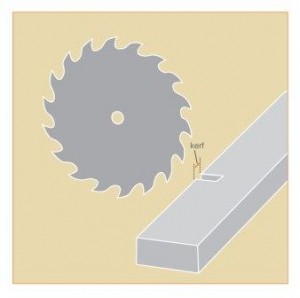Power saws are extremely useful tools, enabling all types of materials to be cut and shaped. However, they also have the potential to cause serious hand injuries. The hands are used to guide pieces into the saw, and thus they can be vulnerable.
The severity of the injury can vary tremendously, depending on the specific level at which the injury occurs (fingertip vs. finger vs. hand vs. forearm), the depth of the injury (skin only vs. tendons, nerves, arteries, and bone), and also characteristics of the saw, such as the blade thickness, tooth pattern, and type and force of the saw. Jigsaws will tend to have a finer, sharper cut, whereas a chain saw is much more powerful with an aggressive blade that can tear out more tissue from the hand or finger.
 Figure 1: Kerf (width of cut made by saw blade)
Figure 1: Kerf (width of cut made by saw blade)
A saw blade is often rated by its kerf, which describes the width of the cut made by the blade (see Figure 1). A bigger kerf means that a thicker or wider defect will be cut out by the path of the saw blade. Smaller kerfs leave a narrower defect in the material that they cut. The kerf may be wider than the saw blade because the cutting teeth of the blade may be angled outwards. The shape and pattern of the teeth will also vary depending on the particular application of the saw (eg fine cuts as with a jigsaw, or bigger teeth with ripsaws to cut with the grain or crosscut against the grain of the wood). Saws will vary with regard to their action, such as the rotating blade of a circular saw or table saw, the reciprocating action of a jigsaw or scroll saw, and the continuous line of movement of a band saw or a chain saw. Use of the proper type of saw and blade for the intended task is important to avoid binding or kicking back of material, or other problems that can cause injury.
What types of injuries occur with power saws?
Any structure that comes into contact with the saw blade can potentially be injured. Superficial scrapes or more severe cuts can damage the skin. Sometimes a large area of skin can be torn off. Deeper injuries can damage the tendons and muscles that move the fingers, thumb, and wrist, affecting the way they move. Nerves may be cut, resulting in loss of feeling and/or loss of ability to control certain muscles. Circulation may be lost if the arteries are injured. Fractures may result, which can be in the shaft of the bone or in the joint, and sometimes with loss of bone substance. Amputations are also possible. With certain types of saws, there may be much more shredding as opposed to a sharp, fine cut. Electric shocks and burns can also occur with the operation of a power saw.
How are they treated?
Simple cuts may be treated with stitches or bandages. Larger areas of skin loss may need a skin graft for coverage. Tendon and nerve injuries may need to be repaired, but if too much shredding has occurred or there is excessive loss of the tendon and/or nerve tissue, repair may not be feasible. Fractures may need repair with pins, wires, or plates and screws. If a joint is severely damaged, it may need to be fused permanently. Some amputations may be able to be replanted, but if there is too much shredding, it may not be feasible. Amputation of a single finger may be better treated by leaving it off, as the reattached finger may impair the function of the rest of the hand. The goal is to optimize the overall function of the hand, but residual impairment (weakness, stiffness, numbness, loss of parts) is possible with many of these types of injuries.
How are they prevented?
Follow all the safety instructions provided for your power saw. Do not override safety guards; they are there for your protection.
- Never look away from your work.
- Never use your hands to clear the scraps from a sawing worktable, instead, use a long stick.
- Do not wear loose clothing or jewelry around the wrists.
- Keep your finger off the trigger when carrying a portable power saw.
- Do not use the saw to perform a task for which it was not designed.
- Use the correct blade for the application. Set it for the correct depth, to minimize the amount of exposed blade and reduce the potential for binding.
- Use sharp blades. Dull blades cause binding, stalling and possible kickback.
- When starting, let the saw reach full speed before cutting and support the work firmly so it will not shift.
- If the saw stalls, switch off the power and unplug the tool before trying to restart it.
- When working with metal, secure the metal materials with clamps or in a machinist’s vise to keep it from moving.
- Check for proper blade guard operation before each cut.
- When starting or stopping the saw, make sure the work is not touching the blade.
- Lower a table saw blade below the table top when finished.
- Keep a clear head, concentrate, and DO NOT DRINK ALCOHOL before using a power saw!
If you are injured seek prompt medical attention. Delay in treatment can lead to a higher risk of infection or tissue loss. The damage done to a finger, hand or any site often exceeds what may be initially apparent due to the force of these types of injuries. Power saws can cause very serious damage that may result in permanent loss of motion, feeling, and strength, or even in amputation. Prevention is far better than trying to try to deal with the aftermath of an injury.
Download the Power Saw PDF

